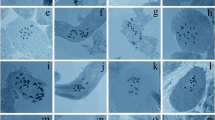Summary
-
1.
Allium species show very little variation in the symmetry of their chromosomes within as well as between their complements.
-
2.
In tetraploid A. macranthum and A. bidwelleae, the complement shows a distinct size differentiation of chromosomes into three groups (Fig. 1).
-
3.
There are mainly six types of nucleolar chromosomes in the genus (Fig. 6). In some species they also carry heterozygosity (Figs. 7–9).
-
4.
In A. stipitatum the heterozygous nucleolar chromosomes also show allocycly which is revealed at the room temperature.
-
5.
Species with supernumerary B-chromosomes are all diploids except A. porrum.
-
6.
There are three basic numbers, i.e. 7, 8 and 9, in the genus. North American species have seven as the basic chromosome number. Most of the Eurasian species have x=8 and a few x=7 and 9.
-
7.
In the section Molium, a group of Mediterranean species, the basic numbers 8 and 9 have arisen from seven in the form of an ascending series, i.e. 7-----8-----9. In the section Codonoprasum which includes European and West Asiatic species, the basic number eight has given rise to both seven and nine.
Similar content being viewed by others
References
Asse, H. N.: In: A California flora by P. A. Munz, and D. D. Kek, p. 1368–1378. Berkeley: California University Press 1959.
Battaglia, E.: Mutazione chromosomica e cariotipo fondamentale in Allium sativum, Caroylogia (Firenze) 16, 1–46 (1963a); - Mutazioni coinvolgenti chromosomi nucleolari in Allium cepa. Caryologia (Firenze) 16, 405–429 (1963b).
Billeri, G.: Osservazioni sul cariogramma di Allium moschatum. Caryologia (Firenze) 6, 45–51 (1954).
Darlington, C. D.: Chromosome botany and the origins of cultivated plants, 2nd ed. London: Allen and Unwin 1963.
—, and L. F. La Cour: Hybridity selection in Campanula. Heredity 4, 217–248 (1950); - The handling of chromosomes. London: Allen and Unwin 1962.
—, and A. P. Wylie: Chromosome atlas of flowering plants. London: Allen and Unwin 1955.
Diannelidis, T.: Cytologischs Studien an einigen Allium. Port. Acta. biol. A 3, 151–171 (1951).
Dowrick, G. J.: The chromosomes of Chrysanthemum. I. The species. Heredity 6, 365–376 (1952).
Dyer, A. F.: Allocyclic segments of chromosomes and structural heterozygosity that they reveal. Chromosoma (Berl.) 13, 545–576 (1963).
Eid, S. E.: Cytological studies in section Molium of the genus Allium. Genetics today. Proc. XI Intern. Congr. Gen. 1, 134 (1963).
Grun, P.: Variability of accessory chromosomes in native populations of Allium cernuum. Amer. J. Bot. 46, 218–224 (1959).
Khoshoo, T. N., C. K. Atal, and V. B. Sharma: Cytotaxonomical and chemical investigations on the North West Indian garlics. Res. Bull. (N. S.) Panjab Univ. 11, 37–47 (1960).
Kurita, M.: Heterochromaty in Allium chromosomes. Mem. Ehime Univ. Sect. II, 3, 23–28 (1958); - Nucleolar chromosome with a long centromere. Rep. Biol. Inst. Ehime Univ., Japan, 9, 1–8 (1960).
La Cour, L. F.: Compound constriction: Appendix to hybridity selection in Campanula by C. D. Darlington, and L. F. La Cour. Heredity 4, 217–248 (1950).
Levan, A.: Cytological studies in Allium. II. Chromosome morphological contribution. Hereditas (Lund) 16, 257–294 (1932); - IV. Allium macranthum, Hereditas (Lund) 18, 349–359 (1934); - V. The chromosome morphology of some diploid species of Allium. Hereditas (Lund) 20, 289–330 (1935); - Zytologische Studien an Allium schoenoprasum. Hereditas (Lund) 22, 1–128 (1936).
Mather, K.: Chromosome variation in Crocus. I. J. Genet. 26, 129–142 (1932).
Mensinkai, S. W.: Cytogenetic studies in genus Allium. J. Genet. 39, 1–45 (1940).
Müntzing, A.: Accessory chromosomes in Poa alpine. Heredity 2, 47–61 (1948).
Noda, S.: A new type of nucleolar chromosome and a supernumerary fragment chromosome in Allium cepa. Mem. Fac. Sci. Kyushu Univ. Ser. E (Biol.) 1, 139–146 (1952).
Ownbey, M., and H. C. Asse: Cytotaxonomic studies in Allium. I. The Allium canadense alliance. Res. Stud. State Coll. Wash. 23, Sup. 1–106 (1955).
Sharma, A. K., and H. R. Aiynager: Occurrence of B-chromosomes in diploid Allium stracheyi Baker and their elimination in polyploids. Chromosoma (Berl.) 12, 310–317 (1961).
Stebbins, G. L.: Self-fertilization and population variability in higher plants. Amer. Naturalist 91, 337–354 (1957); - Longevity, habitat and release of variability in higher plants. Cold Spr. Harb. Symp. quant. Biol. 23, 365–378 (1958).
Tschermak-Woess, E., and H. Schiman: Strukturelle hybriditat und akzessorische Chromosomen bei Allium pulchellum. Öst. Bot. Z. 107, 212–227 (1960).
Author information
Authors and Affiliations
Rights and permissions
About this article
Cite this article
Ved Brat, S. Genetic systems in Allium . Chromosoma 16, 486–499 (1965). https://doi.org/10.1007/BF00343176
Received:
Issue Date:
DOI: https://doi.org/10.1007/BF00343176




